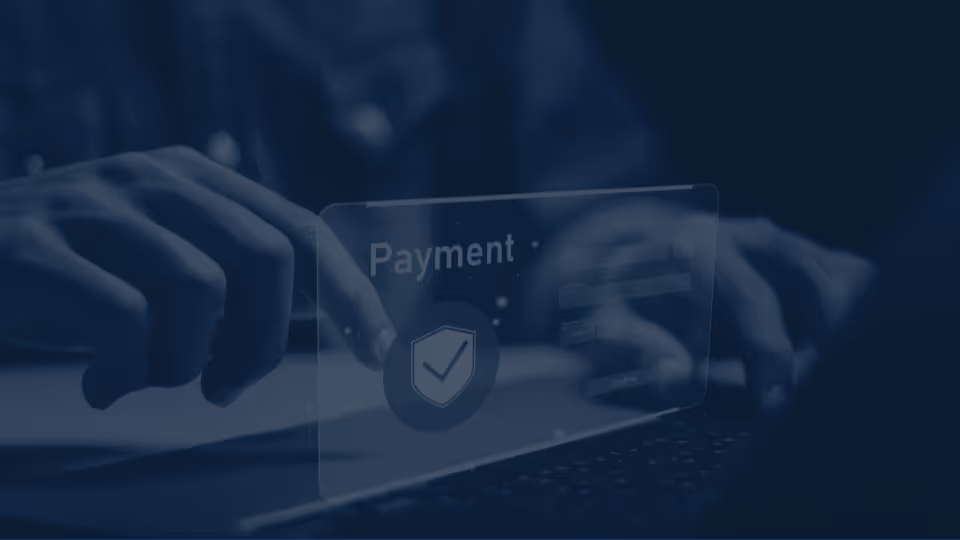Understanding and optimizing B2B payments

According to data from Statista, business-to-business (B2B) payments reached a market size of nearly $197 billion in the US in 2023. Even so, all too many companies have trouble accepting popular payment methods, run into PCI/NACHA compliance issues and regularly struggle with inefficiencies that drag down workflows and drain capital from the business.
Today, the most competitive organizations have a thorough understanding of common B2B payment solutions and are implementing strategies to eliminate manual processes, support automation wherever possible and deliver a rapid and seamless customer experience. To keep up, you’ll need to know which B2B payment strategy is right for you and invest in platforms and smart integrations that maximize the value of your existing systems.
Defining B2B payments
The term “B2B payment” can describe a variety of transactions between companies, including Automated Clearing House (ACH) payments, wire transfers and credit cards. Companies can make these payments in exchange for products, services or information.
Unlike B2C payments, B2B transactions tend to be complex, and managing them efficiently is often a serious business challenge. They may involve large sums and extended timelines that can vary by client and even from one invoice cycle to the next. Multiple stakeholders and in-depth contracts are also common features of B2B payments, and they can further slow down the process by introducing additional layers of approval.
As a result, B2B payments also face unique security and compliance obligations. Businesses must be ready to overcome these obstacles to optimize their B2B payment strategy, and an inability to do so can result in stagnant growth and scaling limitations.
Types of B2B payments
There are many different B2B payment methods, all of which have unique strengths and weaknesses. A few of today’s most common B2B payment types include:
Wire transfers
A wire transfer is a direct payment from one bank account to another. Since this method is instantaneous, it is a popular choice for time-sensitive business transactions. However, that convenience can come with a significant price tag. Wire transfer fees can be as high as $45 per transaction. Wire transfers also require both parties to share confidential financial information, and this can complicate relationships between companies and slow down approval times.
ACH transfers
ACH payments have become the most popular B2B payment method as of 2022, representing nearly 40% of total transaction volume in the U.S. and Canada. These low-cost transactions include formats like:
- Direct deposits
- Fund transfers
- E-checks
The downside of ACH payments is that they are often processed in batches at specific times of day, potentially causing delays of 1-2 days and introducing revenue recognition challenges.
Also, businesses are expected to offer their customers a variety of B2B payment gateway options – especially as they grow and scale.
Platforms like Stripe are excellent payment processing partners that provide a lot of value, but many businesses still reconcile and compile the data manually to make up for their ERP’s limitations. This can slow down business, introduce costly errors and create serious business intelligence (BI) obstacles.
SEPA transfers
Single Euro Payments Area (SEPA) transfers can help you make quick B2B payments if your company regularly does business in Europe. While using this system, you can debit bank accounts within the SEPA zone.
International payments such as SEPA transactions also highlight the value of digital invoices when it comes to optimizing your B2B payment solutions. These invoices are built on data sets rather than manually inputted information, so international systems can easily translate them into local standards and languages.
Physical checks
Paper checks aren’t as popular as they once were, but they’re still a fairly common B2B payment method. Traditional checks come with some unique perks, such as a high level of traceability. However, checks can’t compete with digital payment methods when it comes to speed or convenience, and that’s why easily automated methods like ACH transfers are becoming much more common.
Cash
Handling B2B payments with cash comes with some obvious advantages – for example, a complete lack of processing and annual fees. On the other hand, businesses shouldn’t handle all, or even a majority, of their payments in cash. If they do, they could suffer from a negative cash flow balance.
Credit cards
Credit cards can make transactions incredibly convenient, but it’s best to reserve these cards for small to medium-sized payments. When a company relies on credit cards for larger transactions, it will have to deal with significant fees and potential credit limits.
Digital payment platforms
Finally, digital payment platforms can allow for transfers without exchanging bank account information. Also known as payment gateways, platforms like Stripe enable businesses to offer convenient payment services that are widely accessible to their customers.
Payment gateways can also be linked to your ERP allowing you to skip manual reconciliation and giving you evergreen access to accurate data. This in turn supports everything from an optimized order-to-cash cycle (O2C) to faster insights from business intelligence (BI) tools. Smart integrations like ZonePayments reconcile payment data natively within NetSuite to support automation and eliminate manual workflows across the business.
Common challenges in B2B payments
Because B2B payment methods are both diverse and common, businesses often have to coordinate multiple systems that utilize a variety of data formats to perform basic business functions. Managing the extreme complexity surrounding compliance, security, cash flow and data system integration is a first-order challenge all its own – especially when doing so using manual strategies for tasks like reconciliation.
In these situations, companies can benefit tremendously from integrations that extend the native capabilities of their ERP by coordinating all their data streams. Moreover, these challenges with B2B payments can be amplified by the following business pressures:
- Flexibility expectations: According to a study by the B2B eCommerce Association, 73% of B2B customers would abandon a sale if they encountered friction at checkout. Businesses need to offer as much ease and flexibility for preferred devices and payment options as possible.
- Faster pace of business: According to the Federal Reserve, nearly 45% of businesses believe faster and more streamlined payments will lower their costs.
- Remote and hybrid work: With over 36 million remote workers expected in 2025, B2B payment methods will need to make it safer and simpler to authorize from anywhere in the world.
- Financial crime: J.P. Morgan’s 2023 study indicates that 65% of businesses are victims of B2B payment fraud attacks, and systems need to be optimized to reduce the threat.
Payment terms
While most businesses would love to be paid immediately for their services, B2B payments often require a little choreography because of lags across each customer’s payment agreement. It’s common for payment terms to be net 30, net 60 or net 90, indicating that they will be due in 30, 60 or 90 days.
This can create long paper trails that Accounts Payable needs to stay on top of to successfully close the books. Also, with additional delays from B2B electronic payments that can all vary depending on the method, these numbers can be moving targets as well as long-range ones.
Supply chain issues and volatility are still impacting businesses around the world, and maintaining reliable cash flows has become more of a priority than ever before. Faster and more reliable payment methods represent both a competitive advantage as well as insurance against market instability.
International transactions
While global markets are more accessible than ever through e-commerce, it also introduces a great deal of complexity for the Accounts Payable team. Customers in other countries have different time zones, preferred payment methods, rules and regulations and even simple language barriers businesses need to overcome.
Solutions like ZoneCapture can take care of the heavy lifting by automating communication and payment information for AP as it comes in regardless of the format or time of day. Its 3-way match functionality combines purchase orders, item receipts and vendor bills with a green/yellow/red light alert system to instantly draw attention to inconsistencies. Your team can also customize rules based on amounts, rates and item codes to support international transactions.
Best practices for optimizing B2B payments
Since B2B payments are a cornerstone of today’s business world, your company needs a payment system that won’t create problems for you and your customers. While taking steps to improve your business’s B2B payment strategy, focus on the following areas that can lead to bottlenecks, frustration and inefficiencies.
Accepting multiple payment methods
There’s no such thing as a “perfect” B2B payment method; as a result, every customer will have a preferred way of transferring funds that makes sense for their business model. With that in mind, you should be ready to accept payments from a wide range of sources, including credit cards, ACH and SEPA transfers, payment gateways like Stripe, and other methods.
Automating accounts payable
Traditionally, accounts payable (AP) management has been an inefficient, time-consuming manual process – but that doesn’t have to be the case today. If you have access to AP software powered by optical character recognition (OCR) and AI technologies, you can minimize the time you spend on manual entry and reconciliation.
Preventing compliance issues
Regulations can change on a dime (especially when digital transactions are involved), so keeping up with compliance is often a serious challenge. To avoid legal problems and protect your company’s credibility, you should use a payment system that supports compliance with PCI and NACHA.
Simplifying recurring payments
When your customers have recurring expenses, they may not want to handle these payments manually. Thus, your payment software should be able to automate recurring credit card and ACH transfers, making things as easy as possible for everyone involved.
Optimizing cash flow
Invoicing that isn’t underpinned by automation is already going to drag down your business, but optimizing cash flow also means reducing communications chaos for your AP department. Maintaining an accurate balance sheet manually or on multiple systems can waste countless hours just trying to close the books.
Integrations like ZoneCapture automate the processing of documents, data and invoice generation entirely within NetSuite so your team never has to juggle logins or wait on crucial information to do their job. Also, ZoneCapture builds on NetSuite’s standard 3-way match process to offer extended capabilities and easy-to-recognize alerts, eliminating the likelihood of errors.
Choose the best tools and software for B2B payments
Are you ready to optimize your business’s approach to B2B payments by adopting the best practices listed above? If so, you’ll need the right tools and software for the job. ZonePayments eliminates manual reconciliation and automates digital payment processes while maintaining strict compliance with regulations.
Meanwhile, ZoneCapture will enhance your company’s AP process by automatically scanning and generating vendor bills and credits without requiring you to leave NetSuite. If you’d like to learn more about ZonePayments, ZoneCapture and other Zone & Co solutions, schedule your demo today.
FAQs
- What are B2B payments?
- B2B payments are any type of payment from one company to another. These payments are often larger than personal transactions and come with longer payment terms. Today, the majority of B2B payments are made digitally, and businesses need to optimize how they manage these transaction to maintain cash flow.
- What are the B2B payment methods?
- Businesses can pay in several ways:
- Checks
- Wire transfers
- ACH payments by way of third-party payment gateway platforms like Stripe
- Other forms of electronic funds transfers
- Checks
- Businesses can pay in several ways:
- What are the most common terms for B2B payments?
- Net 30, net 60 and net 90 are common payment terms for B2B payments, but these numbers become less predictable due to delays in the order-to-cash cycle.
- How does Zone & Co help B2B payment processing?
- Zone & Co’s ZonePayments and ZoneCapture tools can streamline B2B payment processing for all parties involved. The former tool allows companies to connect their ERPs to streamline the collection and reconciliation processes. Meanwhile, the latter can simplify accounts payable management with the help of OCR and AI technology.
- What are the most popular types of B2B payments?
- Some of the most common types of B2B payments include credit cards, ACH and SEPA transfers and wire transfers. Since every B2B payment method has unique pros and cons, your business should accept many different payment types.
Recommended resources
Get a Personalized Demo Today
Start a conversation with an expert who asks thoughtful questions and shows you how Zone & Co can solve your unique problem.






.avif)